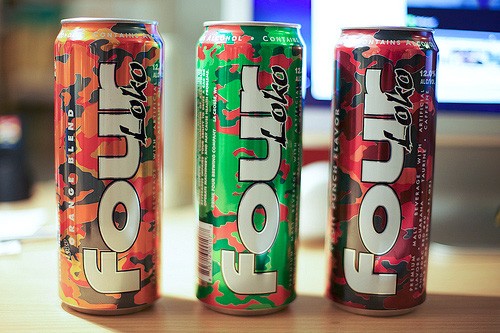ACES discusses truths, myths, lies about alcohol

Courtesy Photo / Google Images Four Loko
Dec 13, 2010
As the holiday season approaches, Alcohol Campus Education and Services and the Grand Valley State University Department of Public Safety are educating students about safe and responsible drinking.
ACES and DPS co-sponsored “Alcohol: Truth, Lies and Consequences” to bring together students, many of whom were underage, and educate them about the safe consumption of alcohol and the legality of drinking. From the beginning, ACES coordinator and presenter Eric Klingensmith said the presentation would be informal and would not focus on telling the 25-30 students that attended not to drink.
“If you drink, do it in a healthy, responsible way,” Klingensmith said. “Our main focus tonight is to bring awareness to the potential issues of drinking.”
Klingensmith used a visual continuum of the definitions of drinking behaviors. The acts ranged from abstinence to responsible drinking, binge drinking, dangerous drinking and alcoholic states of consumption.
“Drinking responsibly is consuming one drink per hour and allowing an hour for your body to rid itself of the drink,” Klingensmith said
When students were asked about is responsible drinking, they replied with responses such as knowing your limits, having a designated driver and not drinking to get drunk.
“Although students think they are being responsible, they make the mistakes of drinking too much in a short period of time or not being aware of how much they are actually taking in,” Klingensmith said.
Two students participated in an exercise in which they were asked to show how much liquor they normally poured in the “red plastic party cup.” Both cocktails contained at least one-quarter of alcohol.
“This is a perfect example of how we’re not always aware of how much we’re drinking,” Klingensmith said. “Each one of their cups actually held three shots instead of one drink.”
One drink is legally considered 12 ounces of beer, five ounces of wine or four ounces of liquor.
“By being a responsible drinker, you eat before or while drinking, which helps prevents alcohol poisoning, and you are aware of your blood alcohol level, which legally shouldn’t be above .08,” Klingensmith said.
In situations in which a friend may have had too much to drink, there are four signs of alcohol poisoning: the person cannot be fully awakened, the individual has clammy or bluish skin, the person’s breathing is slow and irregular or the individual vomits while passed out.
DPS officer Nate Dornbos was in attendance to explain GVSU’s policy when alcohol poisoning is involved.
“If you report a circumstance of alcohol poisoning, we’re here to save lives and not for enforcement,” he said.
The police generally do not give Minor in Possession citations to students on campus who make the call for help.
Most students in the room were under the legal age to drink, but they were honest in their questions and answers.
“I would consider myself a responsible drinker,” said one freshman who attended the event. “I drink at parties to socialize.”
GVSU student Jordan Irving said it was informative.
“I learned how BAC levels are calculated, the difference between responsible and binge drinking, and the consequences of all this,” he said.
According to campus police reports, there were less than 200 alcohol-related incidents on campus last year.






















